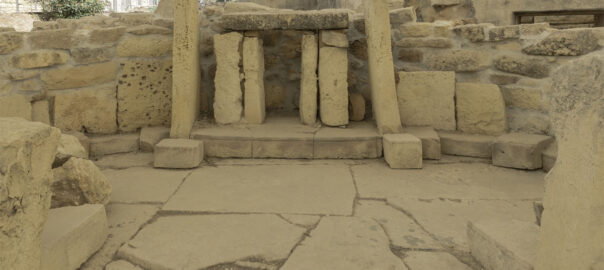
Neolithic Era:
Temples of Malta–A Scientific Breakthrough
Templos de Tarxien, Malta. Diego Delso, Wikimedia Commons
At the foot of Sicily are two islands, Malta and Gozo, where more than 23 megalithic temples once stood. The construction of these temples spanned over a thousand years of continuous building and elaboration, from about 3700 BCE until around 2400 BCE.
Today, they are in various states of ruin ranging from a few foundation stones to four amazingly intact temple complexes: Ggantija, Hagar Qim, Mnajdra, and Tarxien, and a fifth subterranean site, Malta’s Ħal-Saflieni Hypogeum.
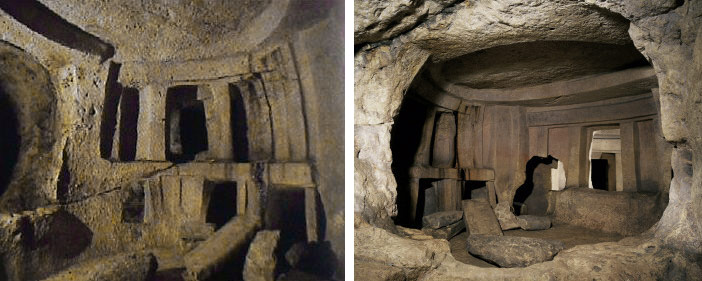
The Ħal-Saflieni Hypogeum is a three-story underground necropolis and temple of complex chambers. Archeologists estimate that the builders used antler picks, stone hammers, and obsidian blades to work through solid limestone bedrock and remove 2,000 tons of rock to create this cave-like underground temple.
Inside the Hypogeum, the feeling is of being inside a womb. Some of its smoothly finished surfaces are decorated with red-ochre spiral patterns, at times interwoven with a honeycomb pattern similar to those found in Paleolithic cave paintings and associated with one of the three universal stages of the trance state.
Openings seem designed for dramatic lighting. Light plays on the curved walls and spaces in a way that make shapes and shadows seem to be seen then unseen, similar to what is observed in the Paleolithic caves. At the winter solstice, light comes in through the main entrance into a ceremonial hall within the heart of the Hypogeum, and on through an elaborately carved chamber into a small room now known as the Holy of Holies that overlooks the burial place for some 7,000 corpses, their bones painted with red ochre.
A most remarkable feature of the Hypogeum is a chamber known as “The Oracle Room,” the ceiling of which, according to Glenn Kreisberg, a radio frequency spectrum engineer, “appears to have been intentionally carved into the form of a wave guide.” The experience is extraordinary and otherworldly. A spoken word uttered in a wall niche possesses exceptional acoustic qualities.
The voice is magnified a hundredfold and can be heard throughout the entire structure, echoing for up to eight seconds. We can imagine the effect when the oracle, god or spirit being spoke and the words came thundering through the dark, mysterious place.

As we saw, the Paleolithic caves in France and Spain would have included spaces with similar acoustic characteristics, but Ħal-Saflieni marks the earliest example of how our ancestors deliberately created spaces which used sound to reach alternate states of consciousness, and most likely to effectively instill social cohesion and compliance in the general population. This characteristic would be evident in the later Neolithic structures, such as the Newgrange passage tomb and megalithic cairns.
Strong Double Resonance Frequency at 70Hz and 114Hz Experienced Inside the Temple
In 2014, an article published by Phys.org and provided by the Mediterranean Institute for Ancient Civilizations noted that:
During testing, a deep male voice tuned to these frequencies stimulated a resonance phenomenon throughout the hypogeum, creating bone-chilling effects. It was reported that sounds echoed for up to 8 seconds. Archaeologist Fernando Coimbra said that he felt the sound crossing his body at high speed, leaving a sensation of relaxation. When it was repeated, the sensation returned and he also had the illusion that the sound was reflected from his body to the ancient red ochre paintings on the walls. …
Sound in a Basso/Baritone range of 70–130 hz vibrates in a certain way as a natural phenomenon of the environment in the Hypogeum, as it does in Newgrange passage tomb, megalithic cairns and any stone cavity of the right dimensions. At these resonance frequencies, even small periodic driving forces can produce large amplitude oscillations, because the system stores vibrational energy. Echoes bounce off the hard surfaces and compound before they fade. Laboratory testing indicates that exposure to these particular resonant frequencies can have a physical effect on human brain activity.
In the publication from the conference on Archaeoacoustics which sparked the study, Dr. Paolo Debertolis reports on tests conducted at the Clinical Neurophysiology Unit at the University of Trieste in Italy: “…each volunteer has their own individual frequency of activation, …always between 90 and 120 hz. Those volunteers with a frontal lobe prevalence during the testing received ideas and thoughts similar to what happens during meditation, whilst those with occipital lobe prevalence visualized images.” He goes on to state that under the right circumstances, “Ancient populations were able to obtain different states of consciousness without the use of drugs or other chemical substances.”
One temple has a hidden stairway between rooms, leading archeologists to believe some rooms would have been hidden, presumably reserved for the priesthood. In the other places small “windows” in the walls that link one area inside the temple with another, or with an exterior shrine, are commonly called Oracle Holes.
Mnajdra South Temple acts as a solar calendar, engineered so that the sun rises directly through the main portal on each equinox. Imagine what it took to construct and place this monumental building so that it tracked the time for the whole year. The importance of predicting the movement of the constellations obviously went beyond agricultural concerns, though the temple was also the place where surplus food was stored and rationed.
These temples were originally roofed, perhaps with corbelled stones, though no one knows for sure. Vision blocking screens, hidden rooms between walls, oracular openings and restricted access to certain areas, all indicate that these were sacred, secret, and magical places created by the priests and myth-makers. Archeologists can tell from the door fixings evident in some temples that the intention was to keep people out, not in. In other words, entrance and exits were restricted. The keepers of these temple systems had control and they wanted to be sure that they, and no one else, maintained it.
In the documentary, Legacy of a Lost Civilization: Extraordinary People of the Temples of Malta, Dr. David Trump and Richard England state, “As the most important structure and the center of the community, the temple was the base of authority…. It was probably a center for food distribution and where surplus was stored. Healthcare, education and worship would all have been part of the function. From the large forecourts and concave stage-like facades, we can imagine that much of the daily activity of the community took place in front of the temple: priests or priestesses stepping forth from the dark interiors to address the crowd from time to time.”
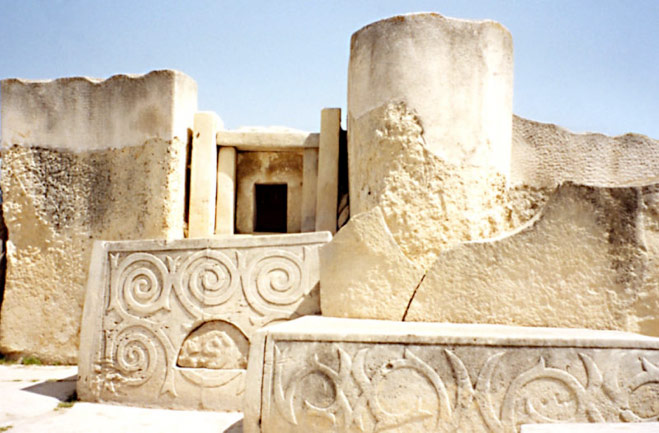
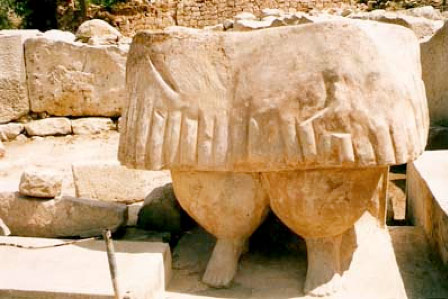


These temples provide evidence that early Neolithic culture included knowledge of architecture, astronomy and audiology a thousand years before the Egyptian pyramids. As people migrated, this knowledge traveled with them, over thousands of years and thousands of miles.
External Stories and Videos
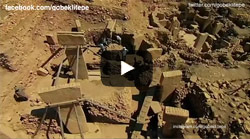
Watch: Göbekli Tepe
BBC
How did the first farmers sustain a large community and build Göbekli Tepe 12,000 years ago?
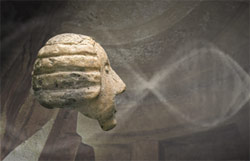
Ancient Architects May Have Been Chasing a Buzz From Sound Waves
The OTS Foundation
“We regard it as almost inevitable that people in the Neolithic past in Malta discovered the acoustic effects of the Hypogeum, and experienced them as extraordinary, strange, perhaps even as weird and “otherworldly.”
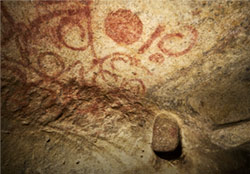
Unveiling an Underground Prehistoric Cemetery
Google Arts and Culture
A look inside Malta’s World Heritage Site, the Ħal Saflieni Hypogeum.
